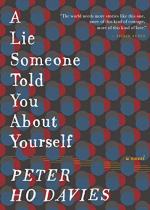|
This section contains 559 words (approx. 2 pages at 400 words per page) |

|
A Lie Someone Told You About Yourself Summary & Study Guide Description
A Lie Someone Told You About Yourself Summary & Study Guide includes comprehensive information and analysis to help you understand the book. This study guide contains the following sections:
This detailed literature summary also contains Quotes and a Free Quiz on A Lie Someone Told You About Yourself by Peter Ho Davies.
The following version of this book was used to create the guide: Davies, Peter Ho. A Lie Someone Told You About Yourself. HarperCollins Publishers LLC., 2021.
Peter Ho Davies' novel A Lie Someone Told You About Yourself is written from the third person point of view, and employs both the past and present tenses. The novel is organized into three sections, each of which contains a series of fragmented narrative parcels. These formal choices enact the characters' distorted perceptions of time, and the protagonist's search for meaning and reconciliation. The following summary relies upon the present tense and a linear mode of explanation.
When the husband and wife learn that their unborn baby has a rare medical condition, they are unsure what to do. No matter what tests they order, the results are consistently inconclusive. None of their doctors can tell them if the baby will be healthy or not. The father is plagued by this entrapping uncertainty. Though they wait some time before making a decision, they ultimately abort the baby, afraid that she will not be normal.
In the months following, the couple struggles to talk about what has happened. The husband does not like naming it, because he feels so much shame and regret. The wife tells him he can write about the experience, as she knows that he uses writing as a sense-making mechanism.
Not long later, the couple starts trying for another baby. Though the sex is good, the husband feels fatigued by it. He also knows that the wife wants a child more than she wants him. Finally she conceives. The baby is born healthy, but must stay in the NICU for several days afterwards. The father is relieved when he realizes how much he loves his newborn son.
The father and mother's life changes after they bring their baby home. Suddenly every facet of their reality is determined by their son's growth and development. For a time, the orderly regularity of their schedule comforts the father, as it grants him a sense of control.
As the boy grows up, however, his teachers begin voicing their concerns. They do think the boy is developmentally delayed. For months and years, the parents repeatedly say they should have him tested. However, they avoid doing so because they fear what the results might reveal.
Meanwhile, the father starts volunteering at a Planned Parenthood clinic. He says the work is research for his writing. With time, however, he realizes that he has been seeking absolution through his volunteering endeavors. The wife is relieved when he quits. She encourages him to be of help at home, and to start thinking of their regret as grief.
Finally, shortly before the boy finishes first grade, they bring him in for evaluation. The doctors say he is twice exceptional, or both challenged and gifted. The parents are confused and frustrated by this dichotomous diagnosis.
The parents enroll Luke at a new school. For a time, their luck seems to be turning.
The father continues teaching and writing. Time seems to pass with exponential speed. He begins to mourn his son's childhood. He begins to contemplate the past and the future with more concentration. He realizes that his son has become a symbol of the future. He is the life that will outlast him, and not simply his stories.
Read more from the Study Guide
|
This section contains 559 words (approx. 2 pages at 400 words per page) |

|



